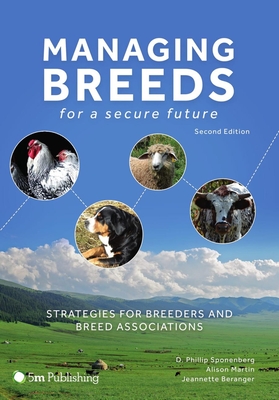Bringing together the experience of three top academic experts in breeding procedure, this up-to-date second edition of Managing Breeds for a Secure Future examines breeding and genetics at a level accessible to all. This new edition has been revised to cover emerging debates in animal breeding and includes domestic species such as dogs and horses.
Bringing together the experience of three top academic experts in breeding procedure, this up-to-date second edition of Managing Breeds for a Secure Future examines breeding and genetics at a level accessible to all. This new edition has been revised to cover emerging debates in animal breeding and includes domestic species such as dogs and horses.The authors skilfully use a clear discussion of theoretical genetics to explain its practical applications to a wide audience of livestock and domestic animal breeders. Specific examples are provided throughout to illustrate how decisions regarding breeding and management relate back to genetic theory.Advice is given on all areas pertaining to the process of responsible breed management from selecting pairs and mating systems to registry functions and long-term management. Current topics of interest covered include: breeding for robustness and disease resistance, international movement of livestock, and preserving endangered breeds. Breed associations are also discussed in depth with particular emphasis on how reducing common conflicts can secure the future of breeds for generations to come.This practical book offers a comprehensive examination of breeding practices aimed at livestock and dog breeders of all abilities and experience levels.The first edition was published by The Livestock Conservancy.
Get Managing Breeds for a Secure Future 2nd Edition by at the best price and quality guranteed only at Werezi Africa largest book ecommerce store. The book was published by 5M Books Ltd and it has pages. Enjoy Shopping Best Offers & Deals on books Online from Werezi - Receive at your doorstep - Fast Delivery - Secure mode of Payment
 Jacket, Women
Jacket, Women
 Woolend Jacket
Woolend Jacket
 Western denim
Western denim
 Mini Dresss
Mini Dresss
 Jacket, Women
Jacket, Women
 Woolend Jacket
Woolend Jacket
 Western denim
Western denim
 Mini Dresss
Mini Dresss
 Jacket, Women
Jacket, Women
 Woolend Jacket
Woolend Jacket
 Western denim
Western denim
 Mini Dresss
Mini Dresss
 Jacket, Women
Jacket, Women
 Woolend Jacket
Woolend Jacket
 Western denim
Western denim
 Mini Dresss
Mini Dresss
 Jacket, Women
Jacket, Women
 Woolend Jacket
Woolend Jacket
 Western denim
Western denim
 Mini Dresss
Mini Dresss






























































